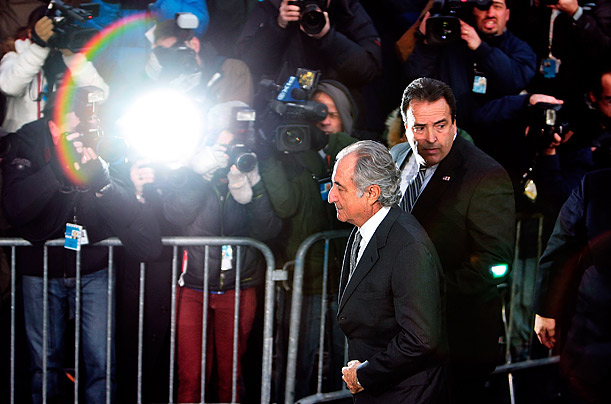Madoff’s Other Legacy
By Justin Fox, courtesy of TIME

One day in fall 2007, I found myself on the 19th floor of the Manhattan skyscraper known as the Lipstick Building, listening to Bernie Madoff explain to me how he made money. This was in preparation for a discussion called the Future of the Stock Market that I was moderating; Madoff was a participant. (It’s a big hit on YouTube — just Google "Madoff video.") Sadly, he didn’t happen to mention the now infamous Ponzi scheme he was running two floors below us. At issue was his legit business, a brokerage that had long been one of the biggest marketmakers (the firms responsible for keeping trading going) on the Nasdaq exchange.
"You’ve heard of payment for order flow, right?" Madoff asked. "Huh?" I responded. Madoff explained that Bernard L. Madoff Investment Securities had pioneered the practice of paying customers to trade through it, thereby siphoning business away from the New York Stock Exchange (NYSE). The firm was able to use its sophisticated computer systems and trading algorithms to earn enough off the spreads between what it bought and sold stocks for to more than offset the amount it paid customers.
This was my first glimpse into the strange modern methods of making money from making markets in stocks. Madoff’s version of it was actually outdated by the time he explained it to me. With the government-ordered advent of decimalization in 2000 (stocks were previously traded in eighths of a dollar) and the rise of nimble competitors, the big spreads that Madoff Securities once feasted on were already a thing of the past.
 Since 2007, the evolution has accelerated. Less than a third of the trading in NYSE-listed stocks is now done through the NYSE — and only a tiny fraction of that by the floor traders, who now function mainly as a colorful backdrop for CNBC broadcasts. Virtually all stock-trading is electronic, and somewhere from 45% to 70% of trading volume is done by high-frequency traders who make their money by the millisecond.
Since 2007, the evolution has accelerated. Less than a third of the trading in NYSE-listed stocks is now done through the NYSE — and only a tiny fraction of that by the floor traders, who now function mainly as a colorful backdrop for CNBC broadcasts. Virtually all stock-trading is electronic, and somewhere from 45% to 70% of trading volume is done by high-frequency traders who make their money by the millisecond.
In the past few weeks, all this has become controversial. Flash orders — a feature offered by some exchanges that allows high-volume traders the advantage of posting orders for up to half a second and then removing them — have drawn the ire of the authorities. Related revelations about the high-speed, almost fully computerized nature of modern stock markets have occasioned no small amount of fear and loathing.
The fear may be justified, the loathing less so. Stock-trading in the U.S. was long dominated by a cartel (the NYSE) that charged exorbitant fees and stifled competition. That cozy arrangement began to fall apart in the early 1970s with the birth of the Nasdaq electronic exchange for small stocks. The rapid growth of Nasdaq companies like Intel and Microsoft, coupled with Madoff’s poaching of orders from the NYSE in the 1980s and ’90s, brought more direct competition. Now things have broken wide open. Nasdaq and the NYSE are still the biggest players, but they must do daily battle with upstarts such as BATS and Direct Edge. Both exchanges have also gone from member cooperatives to for-profit companies — the NYSE by merging with electronic competitor Archipelago.
The cartel is dead and has been replaced by a brutally competitive environment in which the price of trading has plunged. It’s a market in which exchanges do constant battle over trading volume. The biggest volume generators at the moment are high-frequency trading firms you’ve never heard of — GETCO, founded a whopping 10 years ago, is the granddaddy — that try to get ahead of millisecond-by-millisecond price movements and take advantage of rebates paid by exchanges to those who create liquidity (that is, offer to buy or sell stock at a certain price and assume the market risk). Not surprisingly, the exchanges cater to these firms — with flash orders and "co-location" arrangements that put traders’ computers right next to their own, giving the firms a profitable millisecond-or-so edge in trade execution.
In a competitive market, it’s a little hard to say why the exchanges shouldn’t engage in all this. But there is one nagging concern: that equity markets now move so insanely fast that they could go off the rails spectacularly. "I can’t tell you what all this volume of trading will mean," says electronic-trading pioneer E.E. (Buzzy) Geduld, who sold his firm, Herzog Heine Geduld, to Merrill Lynch in 2000. "I can tell you there may be some unintended consequences and this all may blow up." Competition and innovation tend to make markets explode from time to time. And while we wouldn’t really be able to blame this one on Bernie Madoff, you could say he helped light the fuse.


